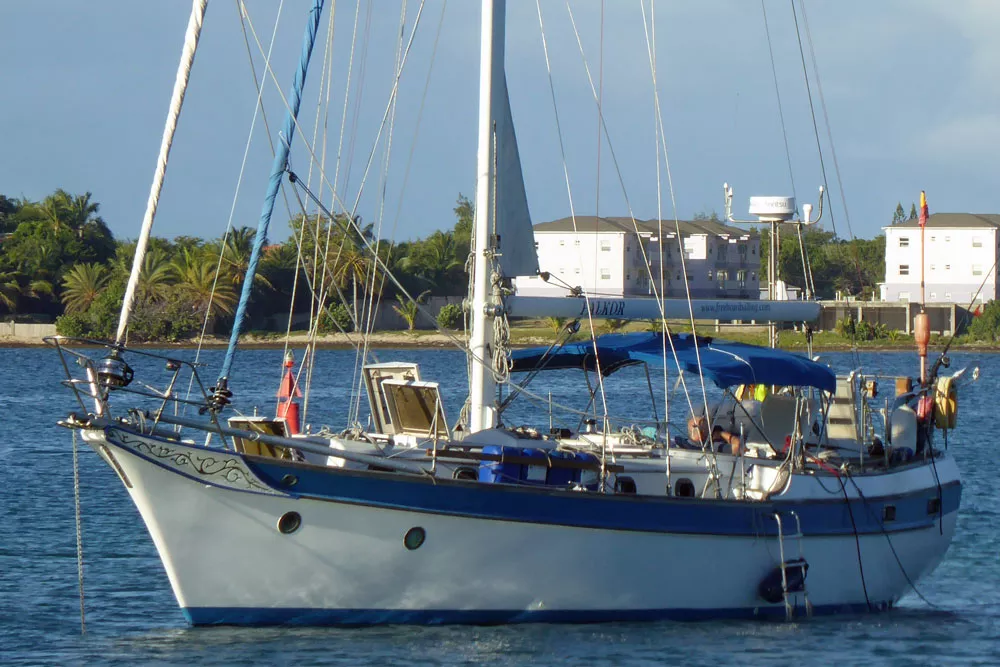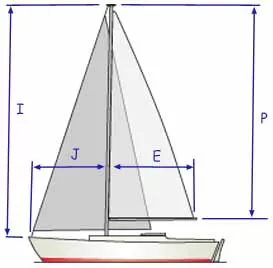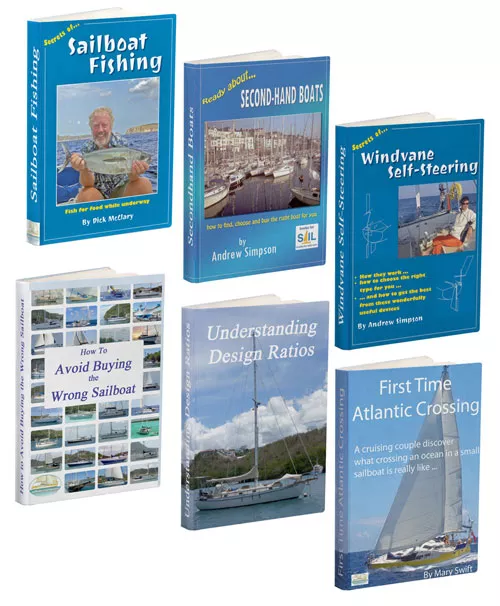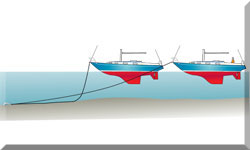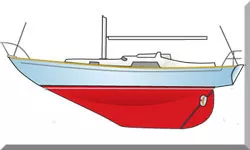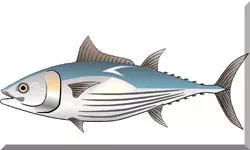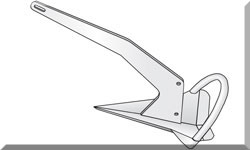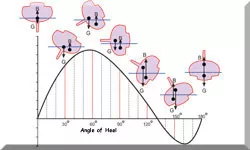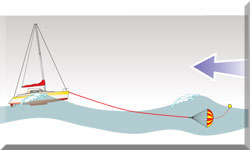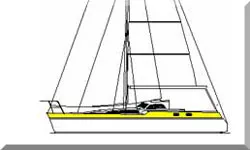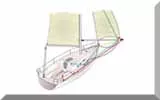- Home
- Cruising Yachts 40' to 45'
- CSY 44
The CSY 44 Mid-Cockpit Sailboat
Specs & Key Performance Indicators
The CSY 44 Mid-Cockpit (aka the CSY 44 Walk-Over) was built by Caribbean Sailing Yachts (CSY), a company founded by David Walters in Florida in 1971.
CSY specialized in building heavy-duty sailboats for chartering in the Caribbean, but also sold some boats directly to private owners or as kits for self-finishing. CSY went out of business in 1981 due to financial difficulties and lawsuits from unhappy customers.
Published Specification for the CSY 44 Mid-Cockpit
Keel & Rudder Configuration: Fin keel & skeg-hung rudder
Hull Material: GRP (Fiberglass)
Length Overall: 44'0" (13.4m)
Waterline Length: 36'0" (11.0m)
Beam: 13'4" (4.1m)
Draft: 6'6" (2.0m), Shoal Draft version 5'0" (1.5m)
Rig Type: Cutter
Displacement: 38,000 lb (17,237 kg)
Ballast: 12,000 lb (5,443 kg)
Water Tank Capacity: 400 gal (1,514 l)
Fuel Tank Capacity: 100 gal (379 l)
Hull Speed: 8.0 knots
Designer: Peter Schmitt
Builder: CSY (Caribbean Sailing Yachts)
Year First Built: 1977
Year Last Built: 1980
Options & Alternatives
Original buyers had several design options to choose from:
- Rig Type: The standard rig was a cutter, but some owners opted for a ketch rig.
- Draft: There were two draft options available: a deep draft of 6'6" (2.0 m) and a shoal draft version of 5'0" (1.5 m).
- Interior Layouts: The interior layouts varied, with options for different cabin configurations. Common layouts included a spacious aft cabin, a forward cabin, and a large saloon area. Some versions also featured additional berths or modified galley and navigation station arrangements.
A further alternative was the CSY 44 Walk-Through version. As it's name suggests, this version had a walkthrough design, allowing direct access from the main saloon to the aft cabin without having to brave the elements. This layout was favoured for its convenience and better protection in rough weather.
Sail Areas & Rig Dimensions
I: 54'0" (16.5 m)
J: 18'0" (5.5 m)
P: 47'0" (14.3 m)
E: 15'0" (4.6 m)
Total Sail Area: Approximately 965 ft² (89.7 m²)
Published Design Ratios
The Key Performance Indicators (KPIs)
Sail Area/Displacement Ratio (SA/D): 16.65
Ballast/Displacement Ratio (B/D): 38.3%
Displacement/Length Ratio (D/L): 301.4
Comfort Ratio: 34.3
Capsize Screening Formula: 1.78
The following analysis of the primary design ratios gives an indication of the boat's likely sailing characteristics, but see the 'Notes of Caution' that follow below:
- Performance: The SA/D ratio of 16.65 indicates a boat with reasonably good performance. It suggests the CSY 44 will be responsive to wind and capable of achieving respectable speeds, making it enjoyable for those who appreciate a bit of spirited sailing.
- Stability and Power: A B/D ratio of 38.3% suggests the CSY 44 is a stable boat with good power. While not extremely stiff, it boasts a good balance between stability and manoeuvrability. It will handle winds confidently, inspiring confidence in a range of conditions.
- Displacement: With a D/L ratio of 301.4, the CSY 44 falls into the Heavy Displacement category. This means it's a heavier boat for its length, contributing to its stability and seaworthiness. It will provide a comfortable motion even in rougher seas, though it might not be the fastest in its class.
- Comfort: The Comfort Ratio of 34.3 indicates a reasonably sedate motion for the CSY 44. This means it's designed to minimize pitching and rolling, prioritizing comfort, making it ideal for longer journeys and those susceptible to seasickness.
- Bluewater Capability: A Capsize Screening Formula of 1.78 suggests the CSY 44 is suitable for offshore passages. The lower number indicates a good balance between beam and displacement, reducing the risk of capsize. While coastal cruising remains an option, the CSY 44 demonstrates the characteristics of a capable bluewater cruiser.
In Summary: The CSY 44 Mid-Cockpit sailboat presents itself as a well-rounded cruiser, prioritizing comfort and stability without sacrificing performance. Its design leans towards a more comfortable, stable ride, making it suitable for extended voyages and handling varying sea conditions. While not a racing yacht, it promises an enjoyable and confident sailing experience for those who appreciate a balance of performance and comfort.
Here's how to calculate the KPIs yourself - without having to wrestle with the mathematics...
Design Ratios: Notes of Caution...
- The Sail Area/Displacement Ratio (SA/D): This ratio provides an estimate of the sail power relative to the boat's weight, which can indicate potential speed in various wind conditions. But it doesn't account for the efficiency of the sail plan, the rigging, or the skill of the crew. Real-world performance can vary significantly based on these factors.
- The Ballast/Displacement Ratio (B/D): This ratio gives an idea of the boat's stability and stiffness, which is crucial for handling and safety. But it doesn't consider the distribution of the ballast or the hull shape, both of which can greatly affect stability. A high B/D ratio alone doesn't guarantee a stable boat if the ballast is poorly distributed.
- The Displacement/Length Ratio (D/L): This ratio helps predict the boat's speed potential and its behaviour in different sea conditions. But it doesn't account for the hull design or the boat's overall weight distribution. Two boats with the same D/L ratio can perform very differently if their hull shapes are different.
- The Comfort Ratio (CR): This ratio estimates the boat's motion comfort in a seaway, which is important for long passages. But it doesn't consider the boat's interior layout, which can also affect comfort. Additionally, personal tolerance to motion varies, so a boat that is comfortable for one person might not be for another.
- The Capsize Screening Formula (CSF): This formula assesses the likelihood of a boat capsizing in heavy seas, which is critical for offshore safety. But it doesn't take into account the boat's handling characteristics or the skill of the crew. A boat with a low CSF can still capsize if poorly handled in severe conditions.
General Limitations
- Static Nature: These ratios are static measurements and don't account for dynamic factors like wave action, wind gusts, or crew actions.
- Simplification: They simplify complex interactions into single numbers, which can be misleading. Real-world performance is influenced by a multitude of factors that these ratios can't fully capture.
- Context: The context in which the boat is used (e.g., coastal cruising vs. offshore racing) can greatly affect how these ratios should be interpreted.
In summary, while these ratios provide valuable insights into the theoretical performance characteristics of a sailboat, they should be used as part of a broader assessment that includes practical experience, sea trials, and expert advice.
This article was written with the assistance of Gemini, a large language model developed by Google. Gemini was used to gather information, summarize research findings, and provide suggestions for the content and structure of the article.
Recent Articles
-
Multihull Autopilot Selection is Not Straightforward
Apr 19, 25 01:25 PM
Whether its for a catamaran or a trimaran, tiller or wheel steered, a multi hull autopilot must be endowed with specific performance characteristics... -
Wheel-Steering Autopilots: Your Questions Answered...
Apr 18, 25 03:45 PM
Whatever your question, you should find the answer here -
Tiller Pilots: Your Questions Answered...
Apr 18, 25 08:18 AM
Got a question about sailboat tiller pilots? Odds are, you'll find the answer here
